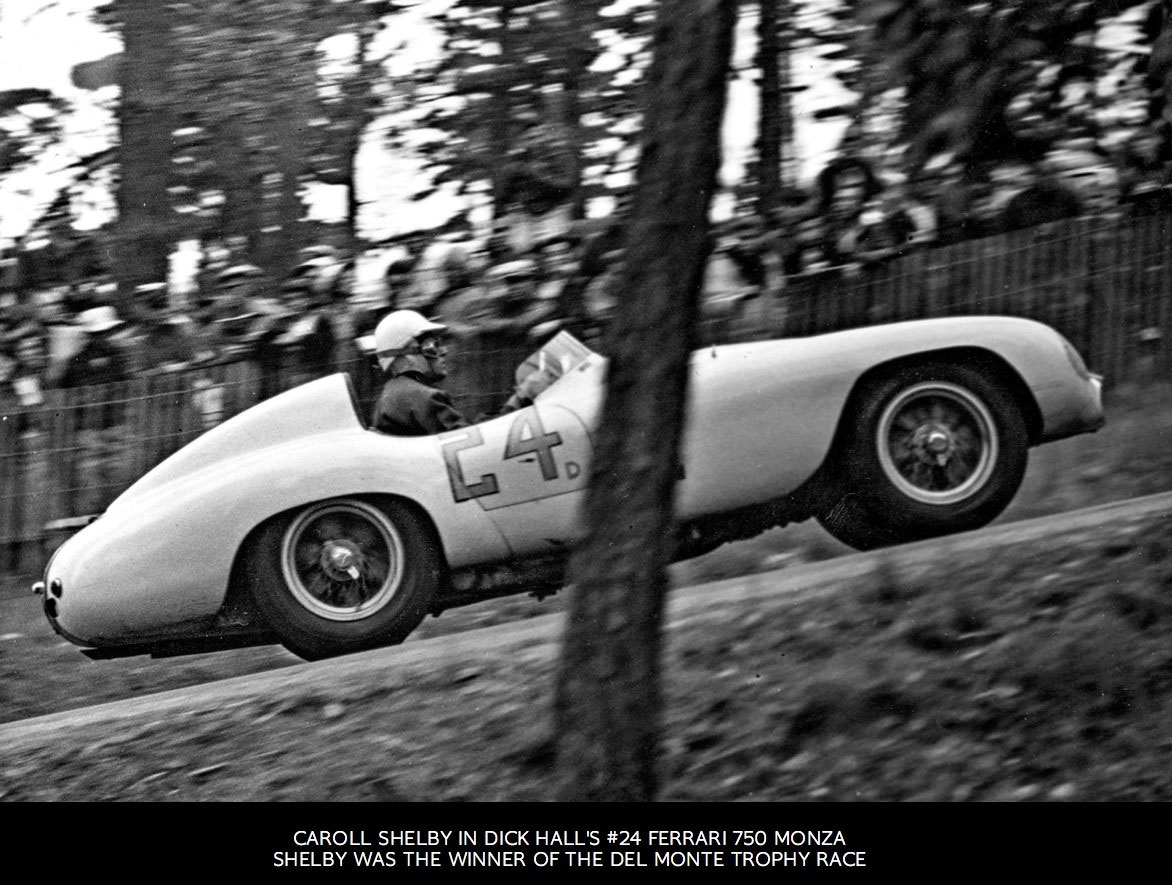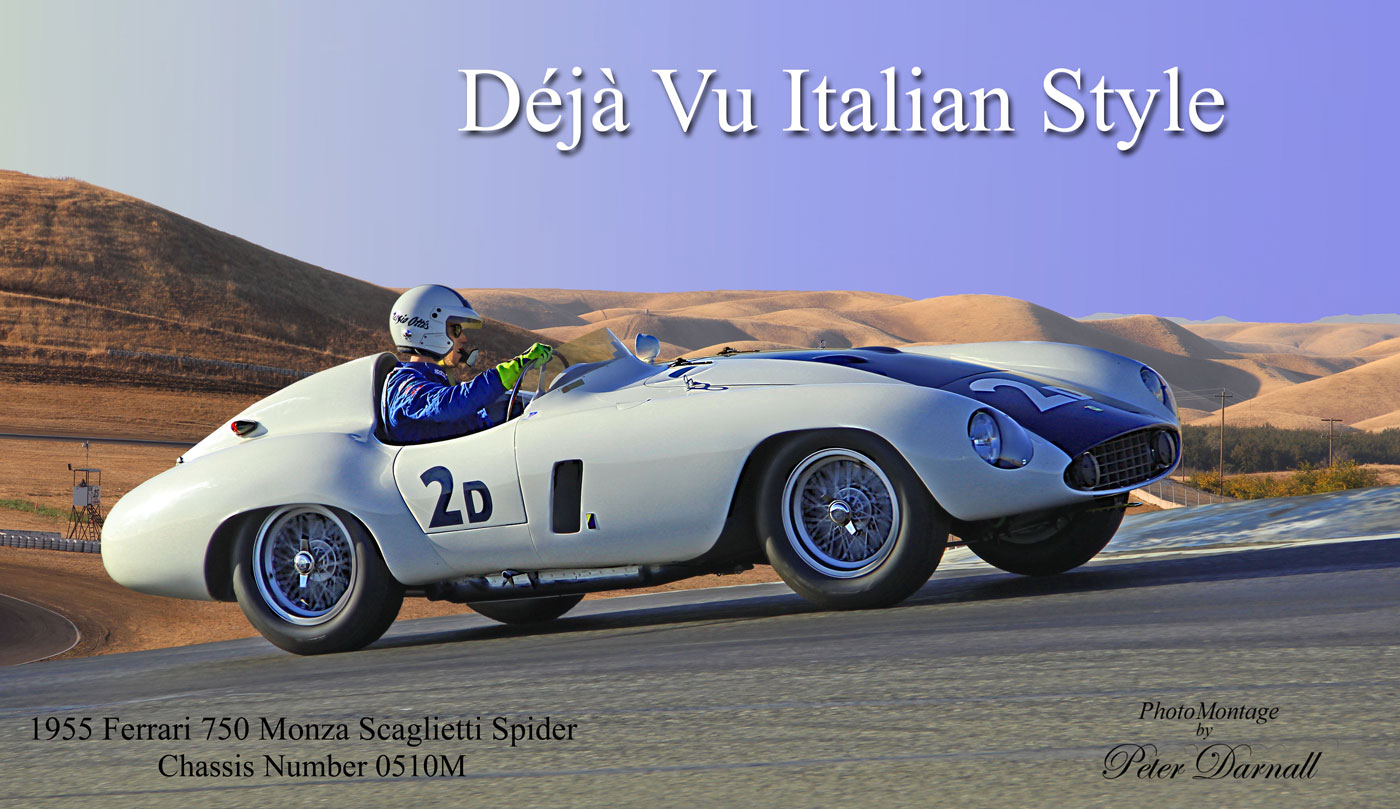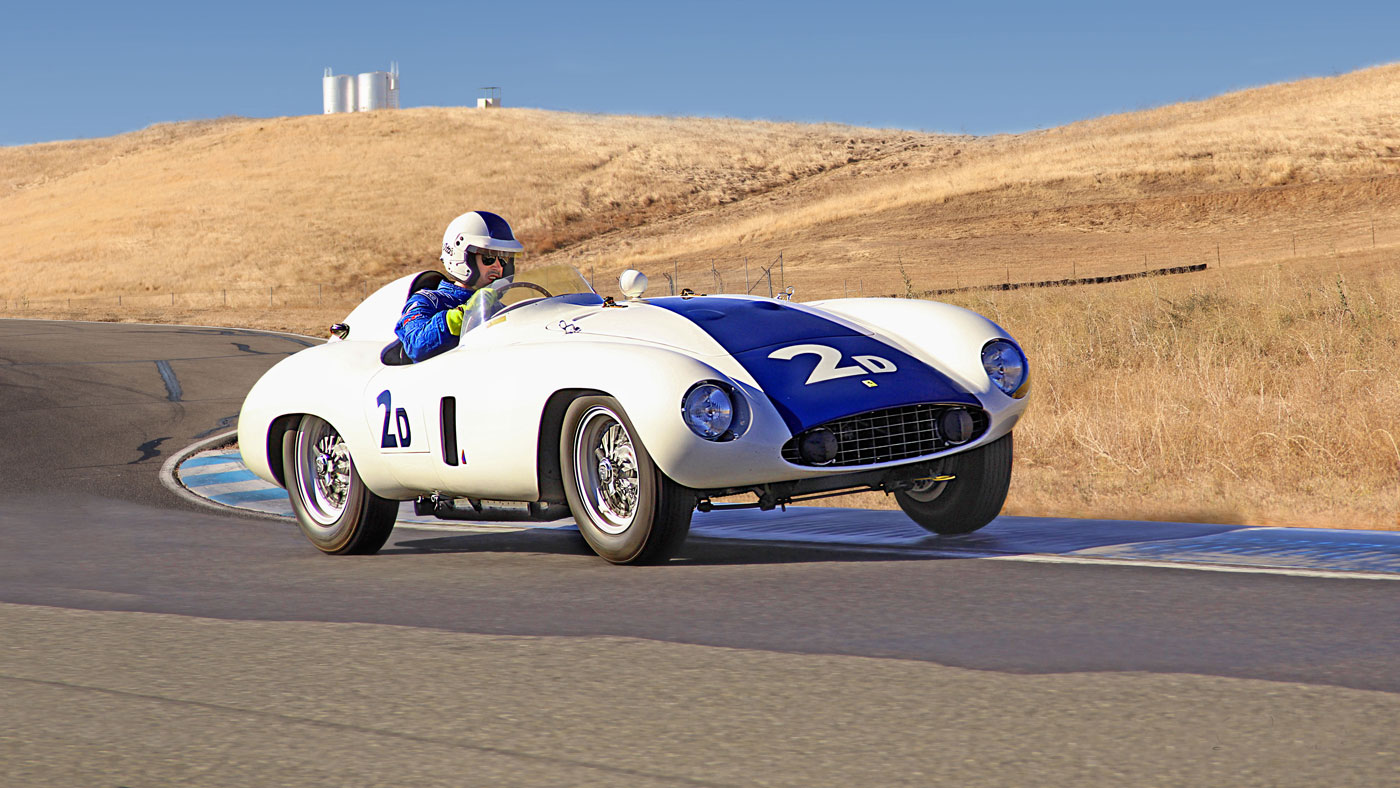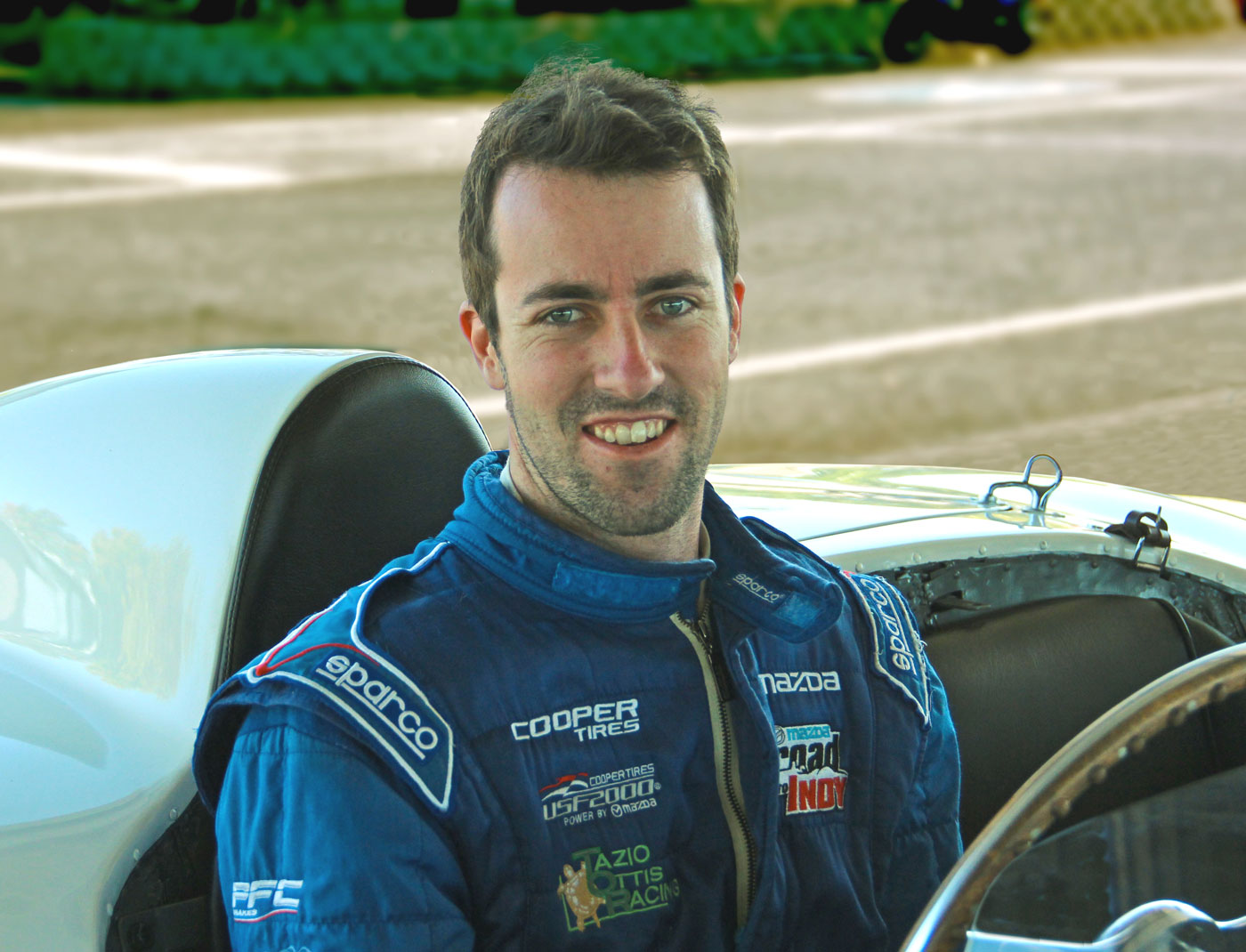By Peter Darnall
Déjà vu: a feeling that one has seen or heard something before . . .
I came across an old friend at Thunderhill recently. I had not seen her in more than fifty years—and she had not changed a bit. She was drawing quite a bit of attention in the paddock, which was just the way I remembered our last meeting in the Del Monte Forest in the spring of 1956.
She is a Ferrari 750 Monza and Carroll Shelby had driven her to victory in the main event at the Pebble Beach sports car races.
There is an aura about these older race cars that goes far beyond mechanical curiosity. They were not pseudo airplanes or fiberglass monstrosities which had been gussied up with tawdry graphics and corporate nonsense. A Ferrari of this era was a work of art. Those elegant compound curves were meticulously hammered out of sheet metal by skilled Italian craftsmen.
The bodywork was created by Carrozzeria Scaglietti. Sergio Scaglietti had been doing modification and repair work on Enzo Ferrari’s creations in the late 1940s and had gained Il Commendatore’s respect for his skills. He set up his own shop across the road from the Ferrari operation in 1951 and enjoyed a close personal relationship with Enzo Ferrari, whom he referred to as “Ingegnere. “ Scaglietti’s shop was also a retreat for Ferrari’s young son Dino, who spent many hours in the facility immersed in a world ringing with the sound of hammers pounding on metal and absorbing the mystique of the metalworker’s ancient craft.
Sergio Scaglietti was from the old school; he preferred to work without plans or drawings using only his intuition to create those elegant lines. Notice that headrest behind the driver which is beautifully flared into the lines of the Monza. This is a Scaglietti innovation which first appeared on an earlier Ferrari prototype. Enzo did not like the appearance, but Dino convinced his father to keep it. Scaglietti’s streamlined headrest has since become a Ferrari tradition and has been widely copied on other designs around the world.
Ferrari’s gamble of replacing the venerable 12-cylinder machines with lighter, less complicated race cars had paid off. A 750 Monza Ferrari was a force to be reckoned with on the American road racing circuits of the mid-1950s.
Following the success of the original Formula 2 four-cylinder engines, which had been resurrected for the World Sports Car Championship in 1953, Ferrari began using the jewel-like Aurelio Lampredi designed units in competition sports racing machinery. These were the 500 Mondial cars which faced off against the traditional V-12s and continued the Ferrari winning ways in international racing.
The 750 Monza was added to the Ferrari arsenal in 1954. Like the Mondial, the Monza was designed to be light and nimble. The 3-liter variant of the Lampredi 4-cylinder engine added increased torque and horsepower over the 2-liter predecessor with little weight penalty to hinder performance. Weighing in with a curb weight of 1,650 pounds, the Monza was hundreds of pounds lighter than its contemporary V-12 alternatives. Weight distribution was further improved by using a five-speed transaxle instead of a conventional transmission. The independent front suspension utilized double wishbones, transverse leaf spring, and hydraulic dampers, while the rear used a de Dion tube with transverse leaf spring and hydraulic dampers.

A historic photograph taken by my late friend Don Palmer during the 1956 Pebble Beach event. This image shows Carroll Shelby in the Monza on his way to victory.
Ferrari 750 Monza, Chassis Number 0510M, was purchased by Allen Guiberson, a Dallas, Texas businessman, in early 1955. Although the car later appeared briefly in rosso corsa (Italian Racing Red), the distinctive white with blue diamond pattern is the original livery. For the first competition outing, Guiberson entered the car in the 1955 running of the 12 Hours of Sebring with Phil Hill and Carroll Shelby as drivers. The Ferrari was initially recorded as the overall winner but lost the victory to a challenge which showed the Briggs Cunningham entered D-Type Jaguar of Mike Hawthorn and Phil Walters had crossed the finish line first. Hill and Shelby still managed to clinch the Index of Performance trophy from this event.
Following the debut at Sebring, Guiberson entered the Ferrari in the Pebble Beach races in April. Phil Hill drove the car to a hard-fought victory to win the Del Monte Cup. At the end of the 1955 season, Guiberson sold the Ferrari to fellow Texan Dick Hall, who retained the driving services of Carroll Shelby for the 1956 season. The Monza would return to Pebble Beach with Carroll Shelby at the wheel.
The 1956 event at Pebble Beach was a special one for me: this was an early outing with my first car, an MG TC. I remember a thrilling run with my friend Jim Fleming, shivering in the open cockpit, as we encountered an early morning fog outside the town of Gilroy, followed by an adrenaline pumping dash through Steinbeck country to the Monterey Peninsula and the Del Monte Forest.
The old Pebble Beach racecourse was not for the timid. The track was narrow and lined with trees. It was laid out on ordinary roads in the Del Monte Forest which were closed to the public for the race weekend. Hay bales were placed on the corners and snow fencing was set up for crowd control. Real cars raced at unbelievable speeds on real roads in those days–a far cry from the insipid made-for-television offerings conducted on safety-engineered designer racetracks that we have today. Carroll Shelby won the Del Monte Cup, duplicating Phil Hill’s victory with the same Monza the previous year. Of course, we had no way of knowing this would be the last event held on the picturesque Pebble Beach course. Far too dangerous, the safety czars decreed.
Following wins at Pebble Beach and Eagle Mountain, Texas, Dick Hall sold the race car interests to his brother Jim, who would drive the Monza to victory at Ft. Sumner, New Mexico. This was the first win for Jim Hall, who would compete in several local races before retiring the car in 1958 to concentrate on his innovative Chaparral machines.
Jim Hall recalled his impressions of the Ferrari in a recent interview with RM Sotheby’s Research & Editorial Department: “I remember driving it for the first time and was amazed by it. It had lots of torque and you had to shift through the gears quickly, but it had lots of go. The brakes were fantastic, even though they were drums. I thought it was a fabulous race car.”
Sadly, when most racing cars pass their competitive days, they are either cut up in a search for more speed or set aside to molder in a in a forgotten scrapheap, Thankfully, the Monza escaped these fates. When the racing days were over, it was put into storage for four decades. In the mid-1990s, Jim Hall decided the Monza needed restoration and turned the job over to Troy Rogers, the former chief mechanic for the Chaparral racing team.
In 1997, the Monza began a new career as a show car. It reappeared in its unique white/blue diamond livery at the Monterey Historics as part of a display of race cars honoring Carroll Shelby. It was later shown at the 2005 Pebble Beach Concours d’Elegance in a display honoring Phil Hill and Stirling Moss. In 2011, it was loaned to the Petersen Automotive Museum in Los Angeles as part of an exhibit honoring Phil Hill.
In 2016, Jim Hall sold the Ferrari through RM Sotheby’s auction in Monterey. The new owner, Patrick Ottis, is the proprietor of Patrick Ottis Company, one of the finest Ferrari restoration facilities in the country. Patrick went completely through the Ferrari to bring it up to his standards. At Thunderhill he confided to me that the Monza “restoration” was really a mechanical checkout due to the car’s age. He gave full credit to Jim Hall’s group for the pristine condition, noting that the hard-to-find bits and pieces were all intact on the car.
The Ferrari was put back on the show circuit and impressed judges with the flawless condition. Following first places at both the Amelia Island and Pebble Beach Concurs events, the Ferrari was brought to Thunderhill. “This is a real race car,” Ottis exclaimed.” She’s back on a racetrack where she belongs. She has been driven by Phil Hill, Carroll Shelby, and Jim Hall. This weekend at Thunderhill, she will run with my son Tazio at the wheel.”
And that, my friends, is provenance . . . with a soupçon of déjà vu.




Back in its natural habitat… the track! Bravo to Patrick and Tazio!
Jim Hall needs a big congratulation for preserving such a fine piece of automotive history for forty years.
Nice images combined with great writing. Thanks for the story.
Great, beautiful, fast… I owned 522M. Actually I owned 1/2, Augie Pabst owned the other. Don’t remember if he got the front or the back!
Interesting article Peter.
Thank you for sharing.
Ronda
Since Jim Hall is mentioned in this article it raises the question, what other historic
cars does Mr. Hall have stored in his old Chaparral workshop. Books have been
written about his Chaparrals but I think an article about his “other cars” would be
very interesting for us readers. Any authors ready to take on this assignment?